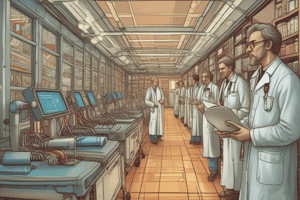Podcast
Questions and Answers
What percentage of medical problems can potentially be diagnosed through proper history taking?
What percentage of medical problems can potentially be diagnosed through proper history taking?
- 70% (correct)
- 80%
- 50%
- 90%
What percentage of medical diagnoses is typically achieved through physical examination alone?
What percentage of medical diagnoses is typically achieved through physical examination alone?
- 15%
- 20% (correct)
- 25%
- 10%
Which of the following is NOT recommended as part of basic hygiene practices for healthcare providers?
Which of the following is NOT recommended as part of basic hygiene practices for healthcare providers?
- Using alcohol-based gel after patient contact
- Using facial creams during patient interaction (correct)
- Washing hands before patient contact
- Wearing protective masks
What is the primary focus of being a physician as stated in the content?
What is the primary focus of being a physician as stated in the content?
Which of the following steps is involved in the handwashing procedure?
Which of the following steps is involved in the handwashing procedure?
What is the primary purpose of giving a running commentary during a patient interview?
What is the primary purpose of giving a running commentary during a patient interview?
Which symptom is specifically associated with sleep apneas?
Which symptom is specifically associated with sleep apneas?
Which type of sputum is typically characterized by being yellow in color?
Which type of sputum is typically characterized by being yellow in color?
What common cause may lead to hemoptysis related to lung conditions?
What common cause may lead to hemoptysis related to lung conditions?
What is the typical appearance of sputum associated with acute pulmonary edema?
What is the typical appearance of sputum associated with acute pulmonary edema?
Flashcards are hidden until you start studying
Study Notes
Importance of History Taking
- Proper history taking diagnoses 70% of medical problems.
- Physical examination alone accounts for 20% of diagnoses.
Protocols for Physicians
- Prioritize safety: Wash hands before and after patient interaction.
- Use alcohol-based gels and personal protective equipment (PPE) as needed.
Handwashing Technique
- Wet hands and cover all surfaces with soap.
- Rub palms together, then interlace fingers and rub backs of hands.
- Rinse thoroughly and dry with a towel.
Effective Patient Communication
- Know the patient's name and introduce yourself with proper identification.
- Obtain consent before procedures and maintain communication throughout.
Basic Components of History Taking
- Approach patients satisfactorily, allowing them time to express themselves.
- Engage in competent and skillful communication.
Key Interview Components
- Establish proper setting and discuss the chief complaint.
- Gather detailed history including present illness, past medical, surgical, medication, family, and social histories.
Major Symptoms
- Upper respiratory: nasal obstruction, discharge, sneezing, epistaxis, sore throat.
- Lower respiratory: cough, dyspnea, chest pain, sputum presence, hemoptysis, wheezing.
Sleep Apnea Symptoms
- Snoring, excessive daytime sleepiness, observed apneas.
Dyspnea Triggers
- Can relate to conditions like bronchiectasis, asthma, and drug side effects.
- Associated risk factors: cigarette smoking, irritants.
Sputum Characteristics
- Assess amount, character (serous, mucoid, purulent, rusty), viscosity, taste, and odor for diagnosis.
Types of Sputum and Related Conditions
- Serous: Clear watery; linked to pulmonary edema.
- Mucoid: Clear/grey; related to asthma or chronic bronchitis.
- Purulent: Yellow; indicates acute infection.
- Rusty: Rusty red; suggests pneumococcal pneumonia.
Hemoptysis Analysis
- Assess amount, type (frank, streaks, dots), duration for diagnostic clarity.
- Common causes include tumors, infections, and vascular issues.
Wheezing and Associated Sounds
- Wheezes are high-pitched, indicative of airway obstruction.
- Stridor expresses turbulent air, often seen in upper airway issues.
Review of Systems in Chest Diseases
- Question about dysphagia, constitutional symptoms, cardiac symptoms, and systemic issues like anemia.
Past Medical History Significance
- Look for previous similar attacks, hospitalizations, and treatments (e.g., TB).
- Consider vaccination history and trauma/surgery details.
Medication History Importance
- Examine prior drug allergies, current medications, and possible interactions.
- Evaluate device usage for respiratory treatments.
Family History Relevance
- Consider genetic predispositions to respiratory diseases: asthma, COPD, cystic fibrosis, etc.
Social History Considerations
- Assess living conditions, occupation, smoking habits, and health insurance status.
Occupational Lung Disease Spectrum
- Types include tracheitis, bronchitis, asthma, cancer, and interstitial disease.
Exposure and Occupation Correlation
- Asbestos exposure links to pulmonary fibrosis; coal exposure leads to COPD.
- Specific occupations raise risk: miners, construction workers, and farmers.
Types of Occupational Lung Disease
- Farmer's lung linked to fungal spores; bird fancier's lung associated with bird droppings.
- Asthma may originate from exposure to various organic dusts and chemicals.
Studying That Suits You
Use AI to generate personalized quizzes and flashcards to suit your learning preferences.




